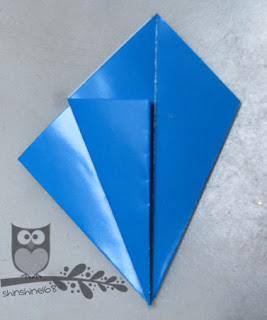With making flower ball, there are gonna be a lot of repetition. It can be frustrating at times, but you are sure to get better with each fold. ^^
Here's what we're gonna need:
22 pcs 7.5 cm orange coloured paper
22 pcs 7.5 cm brown coloured paper
Needle
Sewing thread
1 m yellow coloured ribbon
There are two parts in making a flower. The petals (outer part) and the pistil (inner part). In this case, we're gonna be using the orange paper as the petals and the brown paper as the pistil. In total, we'll be making 22 flowers to make one flower ball.
Of course, it is up to you to select a cute colour combination of your liking to make "The Star". One of the most popular is light blue as petals and dark blue as pistil.
Let's start with the petals:
 |
| Step 1: Start of Valley fold the paper with the coloured paper side up to form a Fruit base. |
 |
| Step 2: Flip the upper right flap of Step 1 to the left, to get the full coloured side. Fold and crease well along the dashed line. |
 |
| Step 3: Flip over, repeat Step 2. |
 |
| Step 4: Repeat Step 2 and 3 to all four full coloured sides. |
 |
| Step 5: Different sides and views of the paper. |
 |
| Step 6: Inside Reverse fold the "petals" with the middle crease perpendicular to the center crease. |
 |
| Step 7: This is what we have upon the completion of the Inside Reverse fold on the four modified sides. |
Now that the petals are ready, we are ready to move on to the next section of the flower, the pistil. This time, we are gonna be working with the brown coloured paper. And this is how we're going to make it:
 |
| Step 1: Start with a paper with the coloured side down to make a Fruit base. On the half coloured side, Valley fold the flaps along the dashed lines, leaving about a third white part on each side. Ensure that the sides of the flaps are parallel to the center crease. |
 |
| Step 2: Repeat Step 1 on the other side, and flip the flaps over and repeat on the remaining two sides. |
 |
| Step 3: This is what it looks like after Step 2. |
 |
| Step 4: Flip to the smooth side, fold and crease well along the dahsed line. Fold as low as it could naturally go. Repeat until all four sides are completed. |
 |
| Step 5: Finished pistil. |
Repeat this to get 22 pistils. And now we have both parts of the flower, like this:
 |
| Pic 1: Petal and Pistil. |
Now, lets combine the two to make a complete flower, like this one:
 |
| Step 1: Take Side B of the pistil and insert so it sits nicely right behind the smooth side of the petal. |
 |
| Step 2: Repeat to get 22 flowers. |
Once we have all the flowers sits nicely like this, we are ready to move on to Part 2: Threading Flowers.
 |
| Pic 2: 22 Flowers and Pistils combined. |












































